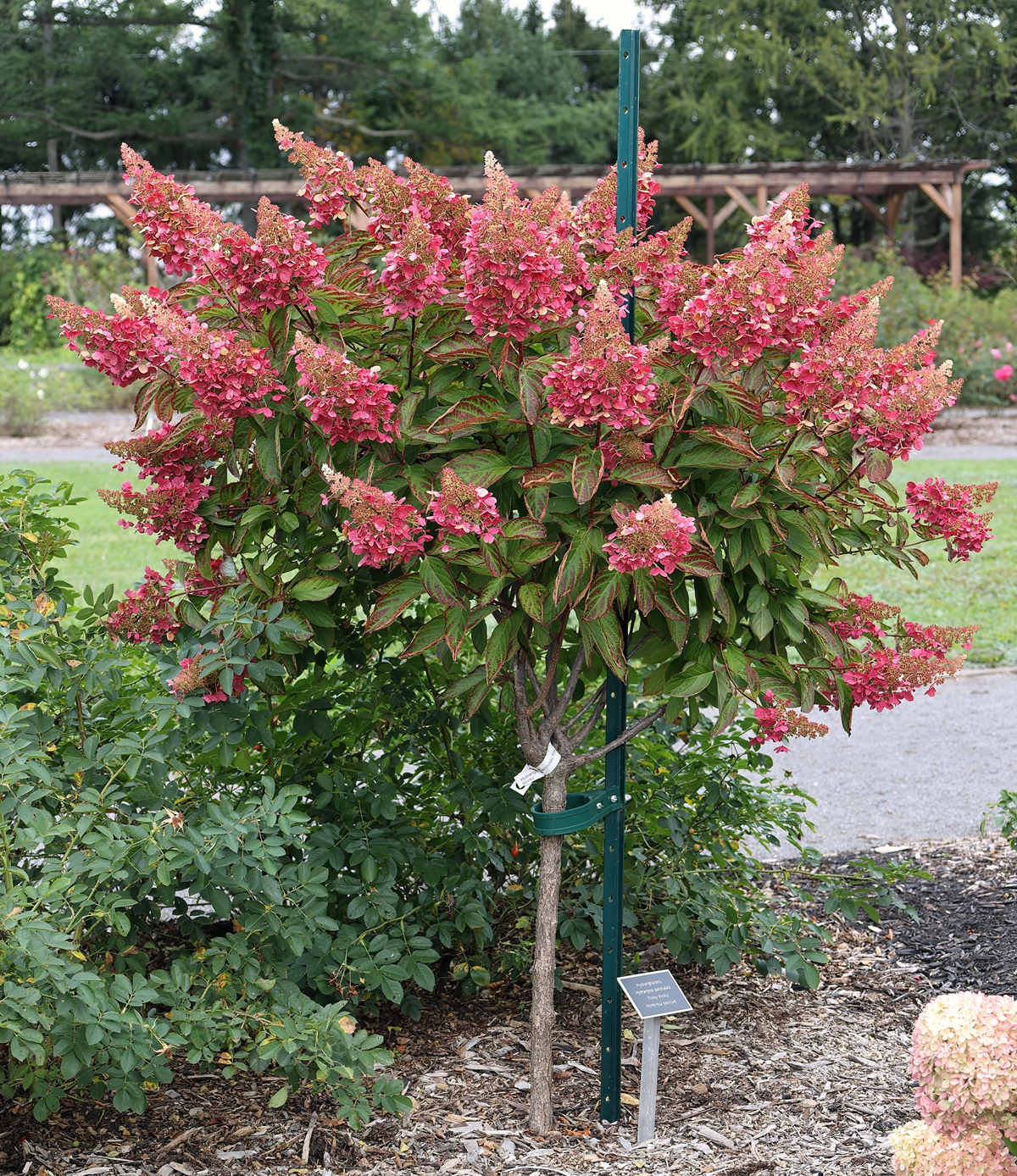
10 Stunning Hydrangea Varieties Loved Across the USA
Discover the top 10 hydrangea varieties loved in the USA. Learn about their unique features, care tips, and how they can enhance your garden.
Read MoreHydrangeas are beloved for their lush blooms and versatility in gardens across the UK and the US. One particularly striking form is the hydrangea tree – also known as a standard hydrangea or tree-form hydrangea. This guide will walk you through everything you need to know about growing and caring for a hydrangea tree, from planting to pruning.

A hydrangea tree is not a separate species but a carefully trained shrub, usually Hydrangea paniculata, pruned into a single trunk with a rounded canopy. This creates the appearance of a small ornamental tree, perfect for focal points in the garden.

When selecting a hydrangea variety suitable for tree form, it's essential to choose cultivars that are both strong-stemmed and produce consistent, ornamental blooms. Most tree-form hydrangeas are derived from Hydrangea paniculata, commonly known as panicle hydrangeas, which are particularly well-suited for this training method due to their upright growth habit, winter hardiness, and reliable flowering.
Below are some of the most popular and garden-proven panicle hydrangea varieties commonly grown as standard trees. These cultivars not only offer striking seasonal interest, but also perform well in both British and North American climates.
These panicle hydrangea cultivars are all deciduous and flower on new wood, which makes them especially reliable bloomers even after hard pruning or late frosts. When grown in tree form, they should be staked when young and pruned annually in early spring to preserve their shape and promote vigorous flowering.
I still remember when I first planted a pair of ‘Limelight’ hydrangea trees at the edge of our front garden, just along the pavement. Only a few days later, I received a rather official-looking letter from our local council office. Apparently, someone had reported that I’d planted trees on public land without permission. I had to explain to them—quite amused—that these were ornamental flowering shrubs, not oaks! Thankfully, all was resolved with a smile, and the hydrangeas stayed exactly where they were. Still, it's a memory I chuckle at every summer when they come into bloom.
Whether you’re looking to create a bold garden statement or add architectural interest to patios or borders, a hydrangea tree cultivar such as ‘Limelight’ or ‘Vanilla Strawberry’ can provide exceptional beauty and structure from midsummer well into autumn.
As you might have gathered from my earlier brush with local council bureaucracy, choosing where to plant your hydrangea tree isn’t just a matter of aesthetics—it can have unintended consequences! But all jokes aside, location truly matters when it comes to the health, shape and long-term success of your hydrangea tree.
Hydrangea trees, typically formed from Hydrangea paniculata cultivars, prefer a position with full sun to partial shade. In most British gardens, a site that receives at least 4–6 hours of morning or early afternoon sunlight is ideal. Too much intense afternoon sun, especially in southern areas, may cause the blooms to scorch or fade prematurely—so dappled shade during the hottest part of the day can be beneficial.
The soil should be moist but well-drained. These hydrangeas are quite adaptable to different soil types, but they perform best in fertile loam enriched with compost or organic matter. Avoid planting in heavy clay or waterlogged soil, as this can lead to root rot or stunted growth. If your garden tends toward clay, consider amending the planting area with grit and compost to improve drainage.
It's also worth selecting a spot that's sheltered from strong winds. While hydrangea trees have fairly sturdy stems—especially varieties like ‘Limelight’ and ‘Phantom’—their large flower heads can act like sails in a summer gust, potentially bending or breaking branches. Planting near a fence, wall, or hedge can provide natural protection without compromising light exposure.
In terms of hardiness, most panicle hydrangeas are well-suited for USDA zones 3–8, which corresponds to RHS hardiness ratings H5–H6—meaning they can withstand temperatures down to -15°C to -20°C. They thrive across much of the UK, from southern England to the Scottish Lowlands, provided they are not exposed to excessive winter wet.
One tip from my own garden: if you’re planting your hydrangea tree along a path or border edge, make sure to allow enough space for its mature canopy. Some cultivars—like ‘Vanilla Strawberry’—can reach over 2 metres in width, which may interfere with walkways or other plantings if not properly spaced. It’s a detail that’s easy to overlook in the excitement of planting, but one that pays off in the long run!
With the right location, your hydrangea tree will reward you with a dramatic display of blooms, a tidy structure, and seasonal beauty for years to come. As always in gardening: a little planning upfront leads to a whole lot of pleasure down the line.
Planting a hydrangea tree correctly is key to ensuring its healthy establishment and long-term success. Whether you're planting in spring, summer, or early autumn, proper soil preparation and planting technique can make all the difference. Follow the steps below for best results.
Proper planting is arguably the most important step in growing a successful hydrangea tree. By taking time to hydrate the root ball, enrich the soil, and ensure firm planting, you give your tree the best possible start in its new location.
Once your hydrangea tree is established in the garden, ongoing care is relatively straightforward. However, like all ornamental trees, it does benefit from consistent attention throughout the growing season—especially in its first two years. Below is a detailed care guide to help your tree thrive and reward you with abundant, healthy blooms year after year.
Consistent care throughout the growing season will ensure your tree-form hydrangea remains healthy, beautiful, and full of blooms. With the right balance of watering, feeding, mulching, and support, your hydrangea tree will become a low-maintenance highlight in your garden.
Regular pruning is essential to maintain the tree-like shape of your hydrangea and to promote healthy, vigorous flowering. Unlike mophead or lacecap varieties, Hydrangea paniculata blooms on new wood, meaning it produces flowers on the current season’s growth. This makes it especially well-suited for late winter or early spring pruning, just before new growth begins.
The main goals of pruning are to preserve the tree form, remove any unwanted growth, and ensure a strong, balanced structure. Here’s how to do it properly:
I'll admit—one year I thought I had made a complete mess of things. After pruning my beloved ‘Limelight’ hydrangea tree, I noticed it was leaning awkwardly to one side. I was convinced I’d overcut one half or missed a balancing branch. However, after some observation, I realised the lean wasn’t down to my secateurs skills at all—it was simply leaning slightly towards the sunnier side of the garden. Hydrangeas, like many plants, naturally grow towards the light. A gentle staking and a slight rotation in the following spring helped correct it over time, and now it stands straight and healthy once again.
This little mishap reminded me of the importance of not rushing pruning and always considering environmental factors, like light direction and exposure. When in doubt, prune lightly and observe—you can always fine-tune the shape the following season.
With proper pruning, your hydrangea tree will reward you with a tidy structure, abundant flowers, and a beautiful silhouette that enhances your garden throughout the season. Don’t be afraid to get the secateurs out—just prune with purpose, and your tree will thank you for it.
Even with the best care, hydrangea trees may occasionally show signs of stress or imbalance. The good news is that most issues can be quickly identified and corrected with a bit of observation and timely action. Below are some of the most common problems encountered by gardeners growing tree-form hydrangeas, along with practical solutions.
With prompt action and a bit of patience, these common hydrangea tree problems can be resolved effectively. The key is to observe your plant closely, understand what it’s trying to tell you, and respond with the appropriate remedy. A healthy hydrangea tree is remarkably resilient and, with consistent care, will continue to flourish season after season.
Yes, dwarf hydrangea tree varieties such as ‘Little Lime’ are well-suited to container growing. Choose a large pot with good drainage holes, use peat-free compost enriched with organic matter, and water regularly to keep the soil consistently moist.
Most standard hydrangea trees reach between 1.8 and 2.4 metres in height when mature. Some dwarf cultivars stay below 1.5 metres, making them ideal for smaller spaces or patio containers.
Hydrangea trees thrive in full sun to partial shade. In hotter regions or during periods of drought, they benefit from light afternoon shade to reduce stress and prevent browning of the blooms.
Prune in late winter or early spring, just before new growth begins. This encourages healthy blooms, maintains the tree shape, and removes dead or damaged wood. Avoid pruning too late, as this may reduce flowering.
The most common causes are insufficient sunlight, over-pruning, or late frost damage. Make sure the plant receives at least 4–6 hours of light daily, and prune carefully to preserve new growth where buds will form.
Yellowing leaves may be due to overwatering, poor drainage, or nutrient deficiencies. Check for waterlogged soil and feed in spring with a balanced fertiliser. Chlorosis (yellowing with green veins) may suggest iron deficiency.
Newly planted trees should be watered 2–3 times per week during dry spells. Once established, weekly deep watering is usually sufficient. Always check the top 5 cm of soil—if dry, it’s time to water.
Use a balanced, slow-release fertiliser (e.g. 10-10-10) in early spring. Avoid excessive nitrogen, which promotes foliage over flowers. Organic options such as compost or seaweed-based feeds are also excellent choices.
Only panicle hydrangeas (Hydrangea paniculata) can be trained into tree form. This process takes several years of selective pruning and support to establish a strong central leader and canopy.
Yes, most hydrangea tree cultivars are RHS H5–H6 hardy, tolerating temperatures down to -15°C or lower. They are suitable for all but the coldest parts of the UK when planted in well-drained soil.
Yes, especially Hydrangea paniculata varieties with fertile florets attract bees, butterflies, and other beneficial insects. They’re a great addition to pollinator-friendly gardens.
Deadheading improves appearance and may encourage a second flush of blooms. Remove spent flowers just above a pair of healthy leaves or a bud node to promote tidy regrowth.
Hydrangea trees prefer moist but well-drained, fertile soil. They are adaptable to a range of soil types but benefit from compost-rich, slightly acidic conditions for optimal performance.
Yes, they are deciduous, meaning they lose their leaves in late autumn. This is normal and part of their seasonal cycle. New growth appears again in early spring.
With proper care, a hydrangea tree will establish within 2–3 years and reach full form and consistent blooming within 4–5 years. It will continue to thrive for many seasons with annual pruning and feeding.
A hydrangea tree can become a stunning focal point in any garden, offering beautiful blooms and structural interest throughout the seasons. With the right care, location, and pruning technique, you'll enjoy this spectacular plant for years to come. Whether in the ground or a container, it's a showstopper in any landscape.

Discover the top 10 hydrangea varieties loved in the USA. Learn about their unique features, care tips, and how they can enhance your garden.
Read More
Discover what to plant with hydrangeas to create a thriving and visually stunning garden. Learn about the best companion plants and their benefits.
Read More
Explore the perfect pairing of peonies and hydrangeas for a gorgeous garden display. Learn about planting, design tips, and seasonal care for these stunning blooms.
Read More